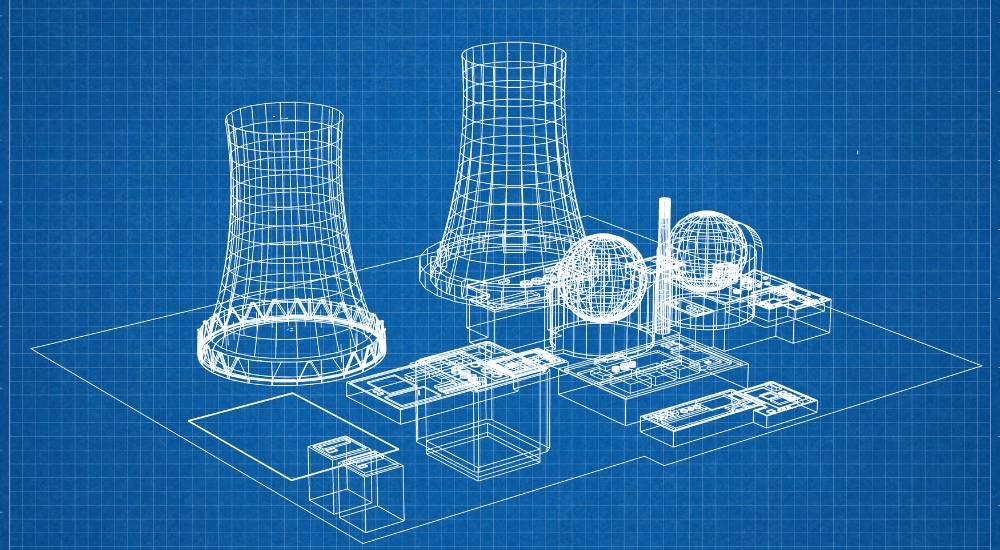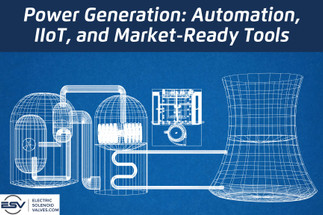Jul 31st 2023
Power Generation: Automation, IIoT, and Market-Ready Tools
The power generation industry is undergoing a major transformation as digital technologies are enabling new levels of efficiency, reliability, and sustainability. With the Electricity demand projected to increase 57% by 2050 (to 38,700 TWh, from 25,000 TWh in 2017), the power generation sector is ramping up to adopt digital transformation and innovative technologies to comply with the global Net Zero 2050 vision, given that the sector is currently the largest source of carbon dioxide (CO2) emissions globally.
While the foundational mechanics and the basic set-up of the power industry remain the same, automation has already been proven to be a key driver with the inclusion of smart grids, intelligent energy management, and distributed energy integration systems. These integrations have equipped power plants to optimize their power generation operations to precisely meet the fluctuating energy demands, and curb energy losses. For instance, reports suggest that technology today is able to increase plant efficiency (heat rate) by up to 3%, reduce the average all-in cost of generation (excluding fuel) by 10 to 20% for coal and 5 to 15% for gas, in addition to ensuring human safety and better working conditions.
Therefore, the study of Automation in Power generation and state of the art is critical for engineers and decision-makers to implement these strategies for their plants. In this article, we will emphasize the overall impact of Automation, IIoT, and aligned technologies on the energy sector, offer case studies, and the implementation tools currently available in the market for power plants.
State of Technology Adoption in Various Power Plants:

To understand the diverse approaches and the level of technological integration within the power generation industry, power plants can be grouped into Four (4) categories:
#1. Conventional Power Generation Stations: These power generation stations, often isolated or located in low energy demand and low-risk areas, rely on traditional operational procedures. These generation stations have minimal automation, typically limited to basic control systems and monitoring. These are prone to face challenges related to efficiency and environmental impact.
#2. Sensors and IIoT-Integrated Power Generation Stations (Remote Monitoring & Control): Offering remote monitoring and control operations, Industrial Internet of Things (IIoT) has transformed power generation by enabling stations to collect real-time data from numerous sensors installed throughout the plant. Today, plant monitoring is facilitated by Drones and UAVs (explored in later sections). The data collected is used for condition monitoring, predictive maintenance, and performance optimization. Through smart sensors installed on machines, equipment health and performance can be closely monitored, allowing operators to proactively address potential issues before they escalate, reducing downtime, and enhancing asset life.
#3. Semi-Automated Power Generation Stations: Semi-automation offers streamlining power generation processes using advanced robotics and Programmable Logic Controllers (PLCs) automate tasks, such as fuel handling, temperature control, and turbine adjustments. These automated systems allow for more precise control, minimizing human errors, and significantly improving operational efficiency.
#4. Integrated (Automated) Smart Power Generation Stations: These are fully automated smart power generation stations with automated monitoring, data processing, and decision-making strategies holistically. Though today such power plants function with either redundant manual interventions, or operate restricted zone with Smart Grids feeding the forecasted energy demands for optimized power generation, research is focused to integrate data analytics, autonomous control systems, and intelligent decision-making processes. The synergy of these technologies allows for dynamic load management, continuous self-optimization, and predictive analytics. This results in exceptional efficiency, reduced operational costs, and a smaller environmental footprint.
ML (Machine Learning) and AI (Artificial Intelligence) models also shall play a crucial role in power plants making real-time decisions, further optimizing energy generation based on factors like demand, machine conditions, resource availability, and environmental impact.
Understanding the Power Generation Components and the Automation Need:

While the primary function of a power plant is to identify electricity demand and generate power, it is essential to recognize the other parallel functions which play a crucial role in supporting the power generation process. Automation in power generation involves studying the power plant as a whole, encompassing its various functions and business operations. These functions and operations include:
A. Energy Management: This involves forecasting electricity load patterns, ensuring accurate energy accounting, and efficient billing processes. The main sub-functions include:
- Load Dispatch: Optimizing the dispatch of power generation units to meet electricity demand and grid requirements efficiently.
- Demand Response: Implementing demand response programs to incentivize consumers to adjust their electricity usage during peak hours, enhancing grid stability.
- Power Purchase Agreements (PPAs): Negotiating and managing agreements with other power producers or consumers to optimize energy trading and utilization.
- Energy Storage Management: Implementing efficient energy storage solutions to store excess electricity and support grid balancing.
B. Facility Management: Power plants heavily rely on comprehensive facility management to monitor assets, manage inventory, and implement proactive maintenance strategies. The functions of the Facility management system include:
- Condition Monitoring: Assessing the health and performance of equipment using condition monitoring techniques to enable predictive maintenance and reduce unplanned downtime.
- Risk Assessment: Identifying potential vulnerabilities in the power plant's infrastructure and developing mitigation strategies to ensure operational safety.
- Spare Parts Management: Ensuring the availability of critical spare parts and maintaining an efficient inventory system for swift equipment repairs.
- Compliance Reporting: Preparing and submitting regulatory compliance reports to demonstrate adherence to safety and environmental standards.
C. Operations Management: This deals with the primary functions of a PP (Power plant), and supervises the Real-time power generation and precise frequency control are essential for grid stability:
- Frequency Regulation: Controlling power generation output to maintain grid frequency within acceptable limits for a stable power supply.
- Load Following: Adjusting power generation output in real-time to match fluctuating electricity demand, ensuring continuous power supply to consumers.
- Black Start Capability: Implementing black start procedures and equipment to restore power generation after a complete grid blackout.
- Remote Monitoring and Control: Utilizing remote monitoring systems to oversee power plant operations and implement control measures from a central location.
D. Fuel Management:
- Combustion Efficiency Optimization: Utilizing advanced technologies to optimize fuel combustion efficiency and minimize greenhouse gas emissions.
- Fuel Procurement: Managing the procurement of fuel resources, negotiating contracts, and ensuring a stable fuel supply chain.
- Fuel Consumption Analysis: Conducting detailed analyses of fuel consumption patterns to identify areas for efficiency improvement and cost reduction.
- Waste-to-Energy Integration: Exploring options to convert waste materials into energy (incineration methods), enhancing sustainability and reducing waste disposal.
E. Environment and Compliance Management: Meeting environmental standards is a key compliance for power plants. This includes:
- Renewable Energy Integration: Integrating renewable energy sources into the power grid and optimizing their contribution to the overall energy mix.
- Environmental Impact Monitoring: Regularly monitoring and assessing the environmental impact of power plant operations on air, water, and soil quality.
- Carbon Footprint Reduction: Implementing measures to reduce the carbon footprint of power generation, including carbon capture and storage technologies.
- Environmental Compliance Audits: Conducting regular audits to ensure compliance with environmental regulations and standards.
The Need for Automation and IIoT in Power Generation:
(The Industry’s conventional challenges, and How Automation offers solutions)
#1. Determining set points: Often power companies look for digital solutions such as data models, to assist them in optimizing set points for critical machinery. Set points refer to predetermined operating parameters or target values, for example in a turbine and compressor (such as Power Output, Inlet Temperature and pressure, blade pitch angle, flow rates, discharge and suction pressures) to ensure optimal performance of these critical machines.
#2. Relaying predictive data to control rooms: While the majority of PPs (Power Plants) started using digital control software to relay parameter data to control rooms, this data can only display real-time site conditions with the sensor readings. However, to forecast and predict machine breakdowns, components (bearings, motors, etc.) health, monitor process limits (if they are set to cross the safety levels), Automation is necessary. Automation can help relay predictive data to control rooms for turbines, compressors and other critical equipment to optimize their performance, and ensure 100% machine availability for continuous power generation.
#3. Breaking down departmental silos: Successful operational excellence initiatives rely on cooperation and transparency across power plants, and especially across divisions – something that may need cultural transformation and breaking down traditional departmental silos to be realized. Automation can help break down departmental silos by providing real-time data and insights across various departments in one dashboard to support cross-functional collaboration.
#4. Optimizing heat rates: Just a few years ago, performance-improvement models based on thermodynamic models and OEM set points were considered an adequate approach to optimizing a plant’s heat rate—the amount of energy needed to produce a single kilowatt-hour (kWh). Today, machine learning can optimize heat rates with much greater efficiency in a fraction of the time.
#5. Adapting to market disruptions: While the power generation industry is facing significant disruption and demand fluctuations due to global geo-political reasons, increased dependency on renewable energy sources, and ambitious decarbonization goals, customer preferences are vastly changing. To address the varying demand, Automation can help power plants adapt to these market disruptions by evaluating the historical trends, connect with grids to provide real-time demand data and insights to optimize plant performance.
#6. Improving unit efficiency and resilience: To remain competitive in the coming decade, power plants must improve their unit efficiency and increase the resilience of their operations to the global energy supply. Automation can help improve unit efficiency and resilience by using AI and ML models to analyze the historical and real-time data, optimize the overall plant performance, to restrict potential losses, and run the plant efficiently.
These are just some of the ways in which automation can help address the real and practical realities faced by the power generation industry on-field. Now, let us see a few case studies on how Automation has successfully been implemented to mitigate the above-said challenges.
Case Studies: Successful Implementation of Power Generation Automation

Case Study #1: Longview Power Plant - Emerson Automation Solution
- Application: The Longview power plant, a 700MW coal-fired thermal power plant, was commissioned in 2011. However, it faced several operational challenges that compromised its ability to reliably supply power to the grid. After only a few years in operation, a two-year, $140 million plant rehabilitation project was implemented to increase availability and reliability, improve capacity factor, reduce forced outages, and enhance operational efficiency.
- Problem Statement: The plant suffered frequent and costly unplanned outages. Its online availability typically ranged from 73-76 percent, contributing to its low-capacity factor of 68 percent.
- Automation Solution: Emerson automation worked to complete the DCS retrofit engineering, which included replacing all hardware and field connections associated with 12,000 I/O, simplifying control logic and graphics, and improving coordination between the boiler and turbine. The project was completed in just 13 months.
- Results: Since the final tuning of the new controls in November 2015, Longview’s online availability has risen to over 98 percent and its capacity factor to more than 98 percent. Net generation has increased by one-third while using less coal and producing 15 percent less CO2 emissions than the average U.S. coal-fired power plant. By avoiding unplanned outages, Longview expects to gain 55,000 megawatt hours and save $3 million in forced outage costs per year.
Case Study#2: TEPCO SYSTEMS Corporation - DataHub Technology
- Application: TEPCO SYSTEMS Corporation (TEPSYS) implemented DataHub technology supplied by Skkynet partner BellChild Co. Ltd. to upgrade data collection, storage, and visualization for a customer operating a hydroelectric power plant in central Japan.
- Problem Statement: Many hydroelectric power plants in Japan rely on outdated business systems and manual data collection methods. This leads to inefficient plant operations, high manpower requirements, and increasing costs. Modernizing and digitalizing these systems is difficult due to the high cost of replacing existing equipment.
- Automation Solution: TEPSYS used DataHub software to automate data collection and distribution without disrupting existing systems or equipment. The software was installed on their self-hosted TEPcube cloud service and connected to most of the control systems and plant equipment via Modbus TCP. Other data was logged to CSV files and aggregated with the other data into a single, universal data set. The team configured InfluxDB to collect the data and provide high-speed access for retrieval, and built screens to display the logged data with the DataHub WebView HMI.
- Results: The implementation of DataHub technology was a resounding success for the power plant, and saved time and manpower up to 50%, along with providing an integrated platform for advanced data analytics, and enabled real-time data access, remote monitoring, and control.
Automation Tools and Strategies for Power Generation Units (Market Ready Tools):

A. Power Plant “Energy Management” - Automation Tools: The prime objective for automation is to track and optimize energy use for cost reduction, decarbonization, and resilience. Some market-ready tools and strategies for automating energy management are:
- GE’s Advanced Energy Management System (AEMS): This solution by GE Digital includes core generation applications for managing fuel sources such as wind farms, PV injection, and storage (batteries). It also includes features such as Automatic Generation Control and Renewable / DER Smart Dispatch and Curtailment to help power plants optimize their dispatch decisions based on real-time market conditions and grid constraints.
- Demand Side Management (DSM): This solution offered by ETAP evaluates and implements energy-reducing strategies such as peak load shifting, load start inhibition, and shedding of non-critical loads to reduce energy costs. It helps utilities identify costly variations in electrical load profiles by determining if and when peak demand usage occurs in a facility.
B. Power Plant “Facility Management” - Automation Tools: This sub-section involves using digital transformation technologies such as cloud, AI, and IoT to bring connectivity to assets inside a building, allowing for data-driven management, optimization, and maintenance. Some market-ready tools and strategies for this sub-section are:
- Smart Condition Monitoring: Preventive maintenance is key for power plants to upkeep machine availability, and companies today are offering IIoT Solutions, integrated as web-based condition monitoring technology to help power plant operators quickly identify equipment problems and make timely corrections. It can also allow experts to live, and remotely monitor multiple sites remotely, adding flexibility to operations.
- Vibration monitoring systems from Emerson is also an affordable yet effective Smart solution for facility management.
- OSIsoft offers the PI System™ which is a data infrastructure that collects, stores, and analyzes real-time data from various sources within a power generation facility. This data can be used to support various functions of Facility Management such as condition monitoring, risk assessment, spare parts management, and compliance reporting.
C. Power Plant “Operations Management” - Automation Tools: This involves implementing an end-to-end digital transformation combining automation and assisted technologies with existing architecture and traditional improvement methods to provide value across operations, maintenance, energy efficiency, and HSSE. Some market-ready tools and strategies available:
- PlantPAx® Distributed Control System: Developed by Rockwell Automation, the solution provides seamless integration between critical process areas and the other sections of the power plant. The platform offers tools such as integrated process control, motor control, safety, and information solutions in a one open and scalable architecture for power generation plants.
- GE’s Energy Management System (EMS): This is a solution offered by GE Power Conversion, designed to manage the electrical power availability of energy-critical industrial plants. The solution enables permanent load balancing between the energy produced and the energy consumed to ensure better global energy efficiency of the plant.
- Automatic Generation Control (AGC): AGC is a popular system used for adjusting the power output of multiple generators at different power plants to respond to the changes in the load and power demand. The solution is used to balance generation and load moment by moment, making frequent adjustments to the output of generators to match fluctuating electricity demand.
D. Power Plant “Fuel Management” - Automation Tools: Automating fuel management involves using advanced energy management systems (AEMS) such as core generation applications for managing fuel sources such as wind farms, PV injection, and storage (batteries). Some market-ready tools and strategies for this sub-section are:
- Integrated Fuel Management System: This is a solution offered by Wipro to help power generation companies with demand forecasting, fuel handling, and managing contracts, processes, and inventory. By providing an integrated approach to fuel management, the solution helps power generation companies improve their electricity cost control.
- Solenoid valves based Fuel Management system: Integration of Solenoid valves is an excellent and cost-effective method to automate power plants, to control fuel flow to the combustion chamber. These valves can be remotely operated using SCADA, HMIs, PLCs and even relays, by using an electric current to open or close, allowing or shutting off the flow of fuel.
By precisely controlling the flow of fuel, solenoid valves can help optimize fuel combustion efficiency and minimize greenhouse gas emissions. Market leaders like ElectricSolenoidValves and Emerson offer a wide range of Solenoid valves (SV). Of them four solenoid valves are pertinent and commonly used in the Power generation industry:
- Gas and fuel solenoid valves: These Solenoid Valves control the flow of gas and fuel to the combustion chamber, allowing for precise control of fuel combustion efficiency and minimizing greenhouse gas emissions.
- Steam Solenoid valves: As the name suggests, these SVs control the flow of steam in power generation systems, controlling steam generation and utilization.
- Pilot valves: These SVs are used to control the operation of larger, main valves in power generation systems, allowing remote and automated fluid flow control.
- Vent valves: These Solenoid valves are deployed to automate the release of gases or liquids (often hazardous) from power generation systems, allowing for safe and efficient venting of excess pressure or fluids.
Every Solenoid valve mentioned above is designed and tested for high-flow and pressure applications of power generation, where safety and reliability are critical.
E. Power Plant “Environment and Compliance Management” - Automation Tools: Compliance management tools use integrated solutions applied for power plants and fleets with an objective to help facilities meet environmental and regulatory compliance requirements. A market-ready tools available for deployment is:
- GE’s Power Conversion tool: This is solution offered by GE Power Conversion is designed to manage the electrical power availability of energy-critical industrial plants by enabling permanent load balancing between the energy produced and the energy consumed. It helps ensure the global energy efficiency of the plant while limiting greenhouse gas emissions.
Benefits of Integrating Automated Systems in Power Generation:
Integrating automated systems in power generation offers a range of direct and indirect benefits that positively impact operational efficiency, reliability, and sustainability. Here are the key benefits:
- Improved Grid Stability: Automation enhances frequency and load control, ensuring a stable power supply and minimizing the risk of grid instability or blackouts.
- Improved efficiency: Advanced automated (AI or ML) algorithms and sensors optimize the combustion efficiency, steam cycle efficiency, and electrical efficiency of power generation processes, reducing the specific fuel consumption and increasing the net heat rate of power generation.
- Real-Time Monitoring and Control: Continuous monitoring of critical equipment and processes enables health assessment and predictive maintenance, allowing for planned response to changing conditions and potential issues.
- Reduced operational costs: Using automation allows optimization of power generation processes, reducing the fuel consumption, maintenance costs, emissions costs, and other operating expenses.
- Enhanced safety: Automated systems can use safety instrumented systems (SIS) and emergency shutdown systems (ESD) to monitor and control hazardous processes, reducing the risk of fire, explosion, or toxic release and improving the safety of power plant operations.
- Reduced environmental impact and Regulatory Compliance: Integrating emission control technologies and carbon capture and storage technologies optimizes the power generation processes, reducing the carbon dioxide, nitrogen oxide, sulfur dioxide, and particulate matter emissions, and ensures compliance with environmental regulations and standards such as the Clean Air Act, the Clean Water Act, and the Renewable Portfolio Standards.
To conclude, implementing automated systems in power generation, power plants can optimize their processes, reduce fuel consumption and greenhouse gas emissions, monitor the health and performance of equipment, enable predictive maintenance and reduce unplanned downtime.
Summary - Forecasts and Future scope of Automation in Power Generation:
The future of automation in power plants is promising, with research showing that end-to-end digitization can realize additional average earnings before interest, taxes, depreciation, and amortization (EBITDA) potential of 20 to 30 percent. The focus of research work in this area is on shifting from traditional power plants to digital power plants by implementing tech-enabled transformations that combine new technologies with traditional improvement methods, across four key areas of: operations, maintenance, energy efficiency, and health, safety, security, and environment (HSSE) and contaminants.

